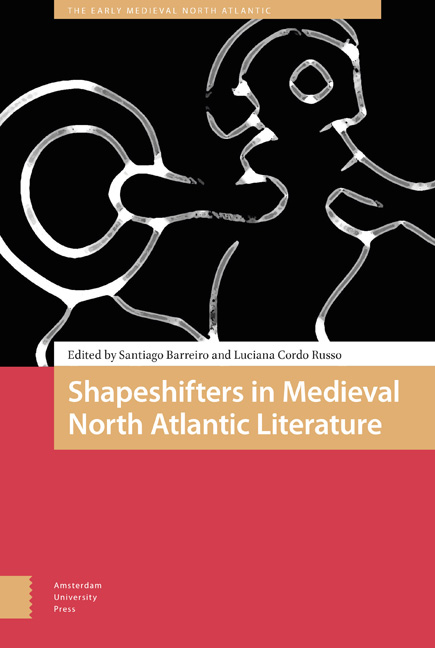Book contents
- Frontmatter
- Contents
- Acknowledgments
- Introduction: Medieval Thought and Shapeshifting
- 1 Wundor wearð on wege‘a wonder happened on the way’: Shifting shapes and meanings in Old English Riddles
- 2 The Big Black Cats of Vatnsdalr and Other Trolls: Talking about shapeshifting in medieval Iceland
- 3 The Hoard Makes the Dragon: Fáfnir as a Shapeshifter
- 4 Eigi í mannligu eðli: Shape, Monstrosity and Berserkism in the Íslendingasögur
- 5 The Cursed and the Committed: A Study in Literary Representations of ‘Involuntary’ Shapeshifting in Early Medieval Irish and Old Norse Narrative Traditions
- 6 Unde sunt aues istae?: Notes on Bird-Shapeshifting, Bird Messengers, and Early Medieval Hagiography
- 7 Sin, Punishment, and Magic: Changing Form in Medieval Welsh Literature
- Index
2 - The Big Black Cats of Vatnsdalr and Other Trolls: Talking about shapeshifting in medieval Iceland
Published online by Cambridge University Press: 16 February 2021
- Frontmatter
- Contents
- Acknowledgments
- Introduction: Medieval Thought and Shapeshifting
- 1 Wundor wearð on wege‘a wonder happened on the way’: Shifting shapes and meanings in Old English Riddles
- 2 The Big Black Cats of Vatnsdalr and Other Trolls: Talking about shapeshifting in medieval Iceland
- 3 The Hoard Makes the Dragon: Fáfnir as a Shapeshifter
- 4 Eigi í mannligu eðli: Shape, Monstrosity and Berserkism in the Íslendingasögur
- 5 The Cursed and the Committed: A Study in Literary Representations of ‘Involuntary’ Shapeshifting in Early Medieval Irish and Old Norse Narrative Traditions
- 6 Unde sunt aues istae?: Notes on Bird-Shapeshifting, Bird Messengers, and Early Medieval Hagiography
- 7 Sin, Punishment, and Magic: Changing Form in Medieval Welsh Literature
- Index
Summary
Abstract
This study examines the ambiguity and mutability of magic in the Middle Ages and the close relationship between magic and shapeshifting. The medieval shapeshifting discourse is vague and leaves much of the creation of meaning to the audience, both concerning what is shape, what does a metamorphosis entail and what are the connotations of magical metamorphosis. Furthermore, it is examined how the state of troll is much beholden to the point of view of the beholder.
Keywords: Magic, paranormal, transmogrification, Iceland, sagas
The great cat massacre
In chapter 28 of Vatnsdoela saga, the audience is introduced to a man called Þórólfr the Hammer who became a great troublemaker, thief and a general nuisance (‘inn mesti óspekðarmaðr, bæði var hann þjófr ok þó um annat stórilla fallinn’). His company is unwanted by all and even though he is not aided in his reign of terror by a human posse of impressive size, he does possess another weapon ‘tuttugu kettir; þeir váru ákafliga stórir ok allir svartir ok mjǫk trylldir’ (twenty cats; they were extremely large and all black and much entrolled). In the face of this demonic presence, the people of the region eventually turn to the local magnate Þorsteinn Ingimundarson to complain about Þórólfr’s looting. They tell him that it is a question of honour for him to cleanse his region of this bandit, even though Þorsteinn is somewhat reluctant to sacrifice his men in combat with the ‘entrolled’ cats.
Certainly, when Þorsteinn arrives with a great army at Þórólfr’s abode, Sleggjustaðir, the latter is as unperturbed as modern supervillains also tend to be in the face of adversity. He gloats that he will defend his house with the fiendish cats: ‘Síðan magnaði hann þá mjǫk, ok váru þeir þá stórum illiligir með emjun ok augnaskotum’ (‘Then he greatly infused them with magic and they became very sinister with their wailing and eye-rolling’). Þorsteinn’s only recourse is to burn down the house, urging his men to keep safe from the cats. The villainous Þórólfr, again in perfect harmony with modern pop culture narratives featuring supervillains, eventually escapes the fire with his silver and is chased by a fearless Norwegian; a chase which ends with them both sinking into a mire. After the fire Þórólfr’s farm becomes desolate, but it is remarked that ever since people have been known to see cats there.
- Type
- Chapter
- Information
- Shapeshifters in Medieval North Atlantic Literature , pp. 43 - 52Publisher: Amsterdam University PressPrint publication year: 2018



